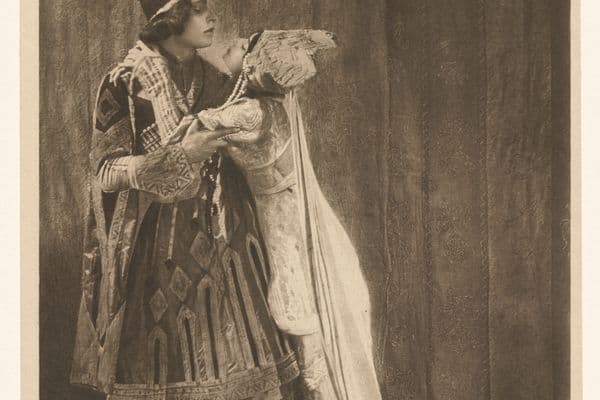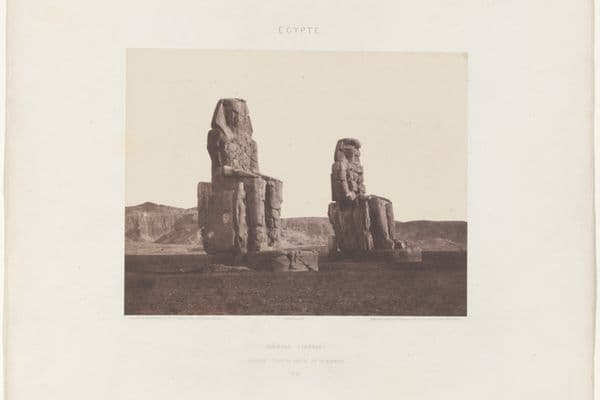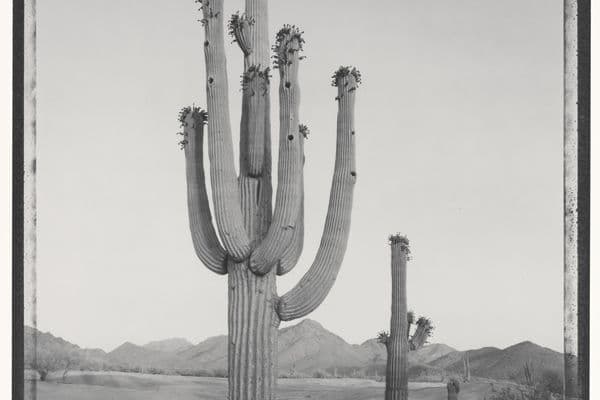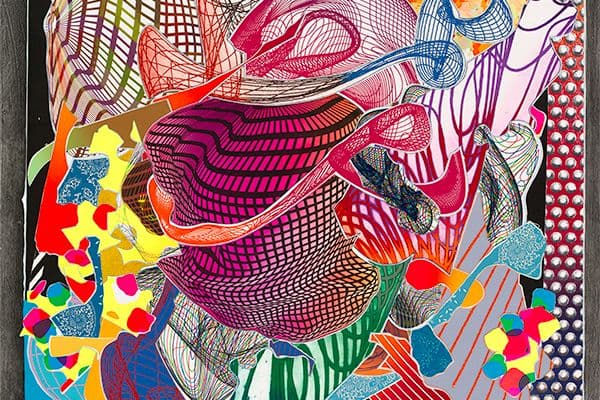Diaghilev's Designers
The Second Generation
15 Nov 1986 – 14 Jun 1987

Giorgio de Chirico, Costume for a male guest, 1929, National Gallery of Australia, Kamberri/Canberra, purchased 1984 © Giorgio de Chirico/Copyright Agency
About
This exhibition focuses on theatre costumes designed by six major artists: Sonia Delaunay, André Derain, Henri Matisse, Natalia Gontcharova, Pavel Tchelitchev and Giorgio de Chirico. Engaged by Serge Diaghilev to produce sets and costumes for his company Les Ballets Russes de Serge Diaghilev, these men and women were responsible for some of the most spectacular episodes in the history of stage design.
The content on this page is sourced from: Healy, Robyn. Diaghilev's Designers: The Second Generation, Gallery 3A 15 November 1986 to 14 June 1987. Canberra: Australian National Gallery, 1986.
Exhibition Pamphlet Essay
The Ballets Russes first visited Paris in 1909, bringing with them the finest of Russian dance, choreography, music and design. The company included the dancer Vaslav Nijinsky, the choreographer Michael Fokine, the composer Nicholas Rimsky-Korsakov, and artists such as Léon Bakst and Alexandre Benois. The ballets on which they worked were to have a lasting influence on all aspects of the visual arts.
With the onset of the First World War and the breakdown of contact with their homeland, the members of Diaghilev's company found themselves stranded in Paris. After the revolution of 1917 contact with Russia ceased altogether, and Diaghilev was obliged to seek a new direction. Moving away from the distinctively Russian style of the Ballets Russes, he began to engage some of the most important artists of western Europe to design his sets and costumes.
Many of these artists had no previous experience in designing for the theatre, and Diaghilev’s commissions provided them with an exciting opportunity to explore and develop their art in a new field. The costumes on display illustrate the diversity of the productions they created for the Ballets Russes from the First World War until Diaghilev's death in 1929.
The costumes designed by Léon Bakst for the first production of Cléopâtre in 1909 were destroyed during the Ballets Russes' Latin American tour some years later. In 1918 Diaghilev commissioned Russian-born artist Sonia Delaunay to design new costumes, and invited her husband, Robert Delaunay, to create the backdrop for the ballet.
By 1918 Sonia Delaunay had already created her first 'simultaneous' paintings, pastels, collages and book covers — works that arose out of the experiments with colour combinations that she and her husband had been developing since before the War. The basis of these experiments was the juxtaposition of colours normally considered disharmonious, and Cléopâtre provided a starting-point for the development of Delaunay’s innovative use of colour and geometric pattern in costume design.
The dancing girl costume, a dress with a bodice of orange and red horizontal stripes, is trimmed with gold and features an orange satin bow. The body of deep blue is stencilled in gold with a pattern of Egyptian figures, and the rust-coloured skirt is decorated with gold spots and a border of gold. The dress has a matching Egyptian collar, also in rust and gold.
The male Egyptian costume comprises a small kilt of green, orange, red and black curving stripes. This repetition of identical slanting stripes is an early form of optical art and was to become a feature of Delaunay’s costume designs. The centre panel of purple is highlighted with an appliquéd Egyptian motif of gold leather, and a purple, black and gold halter was worn with the kilt.
The extraordinary use of colour and pattern in these costumes established Sonia Delaunay’s reputation as an innovator in costume design. Her successes with the Ballets Russes led to further work in the theatre and to her important contributions to fashion during the 1920s.
The artist originally commissioned to design the costumes and sets for La Boutique fantasque, 1919, was Léon Bakst. His submissions were rejected, however, as Diaghilev wished the style of the ballet to be modern: ‘a change from lavish splendour to simplicity and rigid control’.
André Derain was chosen as Bakst’s successor. The first French artist to design for the Ballets Russes, Derain was an original member of the small group of painters who had come to be known as ‘Fauves’ (wild beasts) because of their bold and aggressive use of colour.
Derain not only conceived the décor and costumes for La Boutique fantasque. He also wrote the ballet’s libretto, or story – a tale of a magic toy shop where the toys were capable of coming to life. The backdrop to the scene had windows which looked out onto a landscape of trees, houses and a paddle-steamer, with Derain ignoring conventional perspective in the design of his fantasy world. The tones he employed throughout the ballet were soft harmonies of colours that served to create a calm, idyllic mood. In this they represented a marked contrast to the vibrant colours which has become a distinctive feature of the Ballets Russes productions designed by the Russian artists.
The dancers in La Boutique fantasque were dressed to look like figures from a story book. Among the charming characters were a gentleman in a black velvet suit with patent leather shoots and white spats; a can-can dancer with white frilly petticoats; and two dancing poodles, one white, the other brown.
The white bodysuit of the poodle costume on display is simply highlighted with lines of long white hair, and the tail is tied with a red bow. The dancer also wore a papier mâché poodle snout. The white costume was generally worn for the role of the male poodle, a gruff character who was followed about by the playful female poodle wearing a similar costume in brown and pink.
In 1919 Diaghilev commissioned Henri Matisse to design for the ballet Le Chant du rossignol, 1920. Matisse was already an established and well-known painter, as, as the principal artist of the Fauve group, was regarded as one of the most significant figures in contemporary European painting.
Le Chant du rossignol was set in the Chinese court, and Matisse researched and made many of his designs at the Musée Guimet, which contained a major collection of Chinese art. The stage curtain in black, white and blue was painted with three large theatrical masks supported by griffins, and was scattered overall with flowers to simulate the splendour of the Chinese court. By contrast, the design of the costumes was relatively simple. The garments were based on traditional Chinese styles and were handpainted and appliquéd with stylized motifs.
The mourner costume comprises a Chinese robe of white felt appliquéd with triangles of dark blue velvet, and a back panel with horizontal bands. The hood of the robe has attached ears and horns handpainted with stripes. This unusual costume represents an animal, possibly a deer – the creature the symbolized longevity in Chinese mythology. The pattern on the robe is similar to the markings of the Chinese deer, which has a spotted body and horizontal stripes along its backbone.
The simple cut-out shapes that decorate the mourner’s robe represent Matisse’s solution to the time-consuming sewing techniques of embroidery and intricate appliqué work. This new technique would be further developed in the artist’s famous paper cut-outs.
Natalia Gontcharova, who with her husband, Michael Larionov, was one of the few artists who worked for Diaghilev from 1909 to 1929, the entire period of the Ballets Russes. Gontcharova’s involvement with the theatre began in 1914 when Diaghilev engaged her to design for the ballet Le Coq d’Or. Noted for her fresh and innovative approach to stage design, she continued to produce new styles and conceptions for décor and costume.
In 1922 Diaghilev decided to revive the last act of The Sleeping Princess, a production that had brought his company into financial ruin in 1921 because of its large scale and extravagance. The original costumes and scenery by Léon Bakst had perished in storage, and Gontcharova was commissioned to design costumes for the fairytale characters of the new ballet, which was to be known as Aurora's Wedding.
Among the most memorable scenes from this ballet was the dance of the Ivans, when innocent Ivan and his two brothers performed a vigorous, cossack-style dance. On display is one of the three similar costumes for the brothers. The Russian-style peasant tunic of silver satin is appliquéd with large pink stylized roses and branches in scarlet and blue, while the border of the tunic is embroidered with a gold chain pattern to simulate the shape of a tabard. The pantaloons of blue satin were worn over red boots.
One of the most innovative of the artists associated with Diaghilev in the 1920s was Pavel Tchelitchev. A relatively unknown painter who worked in the abstract style of the Constructivists, Tchelitchev was discovered by Diaghilev in Berlin where he was already designing for ballet and opera.
The ballet Ode, 1928, for which Tchelitchev was commissioned to create the costumes and sets, was about the powers of nature, including water, plant life and the vision of the Aurora Borealis. Tchelitchev used the medium of light to recreate these natural phenomena, and his sets featured images projected on a backdrop of growing plants. Costumes were decorated with fluorescent paint to allow them to glow in the dark, with unusual materials such as net and gauze being used for their transparent qualities. The other modern scenic techniques included neon and coloured strobe lights.
The star costume is a dress of grey artificial silk made in an eighteenth-century style with a bell-shaped skirt. A black hood is attached to the bodice, and a mesh mask was worn over the face. In order to simulate the effect of a shining star, the dress and hood were decorated with random mirror-strip stars which reflect light. Ode was not a popular ballet; most audiences found it incomprehensible, and it was performed for only one season.
The last artist commissioned to design for the Ballets Russes was Italian painter Giorgio de Chirico. De Chirico, who spent most of his working life in Paris, was regarded as a forerunner of the Surrealist movement. Le Bal, 1929, provided him with the opportunity to further his experience in designing for a major ballet company, and he created eccentric effects by incorporating architectural elements into his costumes and sets.
The male guest costume comprises a frock-coat, trousers and 'dickey' (shirt-front), decorated with appliquéd motifs representing both manmade structures and the natural elements of water and air. The frock-coat of terracotta-coloured wool is decorated with Ionic and Doric columns, while the back of the jacket is sky blue, with decorations of a floating cloud above a pediment fragment, two Doric columns, and a pattern of bricks creating the effect of a classical monument set against a blue sky. The cream trousers contribute to the overall effect, with their black painted wavy lines suggesting water. The dickey, appliquéd with an Ionic column, is worn with the frock-coat in lieu of a tie. None of these costumes was practical for dancing, and many of the dancers complained of their weight and stiffness.
Le Bal premiered on 9 May 1929 in Monte Carlo and achieved considerable success. In London, The Times maintained that 'the total effect has that touch of the bizarre which is characteristic of modern design, yet is beautiful in the oldfashioned sense of grateful to the eye'.
Serge Diaghilev died on 18 August 1929, having created a ballet company that resembled a travelling exhibition of the combined arts of dancing, painting and music. In so doing, he made familiar to the general public, through the medium of ballet, some of the greatest artists of his time.











